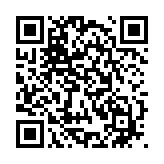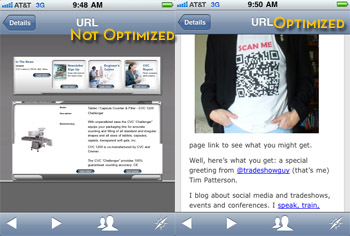
At the Natural Products Expo West show earlier this month in Anaheim, I had the opportunity to scan several QR Codes that were displayed in booths, posters and banners. Some were prominently displayed in large form – maybe a foot square – and others as small as less than one inch on business cards. All in all, I saw perhaps twenty QR Codes. Since I became aware of QR Codes a year ago ago, and have blogged about them a couple of times, I was curious to see how business incorporated the goofy-looking symbol into their marketing efforts.
Here are a few thoughts on what worked and what didn’t:
First, it’s easy to generate a code and stick it on a banner or poster and invite people to scan it. However, the very act of scanning a QR Code should be extremely easy. I found a few codes that were not easy to scan because they were placed in odd locations. One was placed close to the floor, making it difficult to get the camera phone at a good enough angle to capture the QR Code.
Another code was so displayed so small that it was difficult to capture it on the phone. Yet another one was put up high – it was large, but behind a counter which was a barrier to getting a good shot of the code. Finally, one code looked incomplete, as if it was missing a part of it. I scanned it twice and my iPhone app said ‘no code scanned’ even though the guy in the booth insisted it was a good working QR Code. Um, sorry, no.
- Best practice: put the QR Code in an easily accessible location, about 12″ x 12″ in size, with an invitation to “Scan Me!” right above the code. Put it at about head height with no barriers; print it in black ink on a white background. Smartphones need to be able to recognize the code so they can interpret it and take you to whatever information is contained within the QR Code. Include a Call To Action, such as “Scan me to Win!” (I just attended a webinar where the presenter suggested putting QR Codes in odd locations to make it more interesting to scan, such as temporary tattoos…not sure I agree with how practical or effective that would work in the real world!)

Once the code is scanned, the information is processed. Most often the code is a URL (although I’ve seen simple contact information), which spawns the phone’s web browser. Here’s where the marketing thought process tends to break down. Question: what device is used to scan the QR Code? Answer: a smartphone. Since that’s the case, wouldn’t you think it wise to have the web URL optimized for viewing on a smartphone? Of course.
But that’s not the case. Not a single QR Code that I scanned was optimized for a smartphone. Instead, the links all led to a typical HTML page that looks crappy and hard to read on a smartphone.
- Best practice: make sure your web landing page is optimized for viewing on a smartphone. If you have a WordPress blog (like this), it’s easy to install a plug-in that displays the page optimized for a smartphone.
Finally, I scanned one QR Code that was prominently displayed at the entrance to the tradeshow hall. The link was BROKEN! Hard to say why: server could have been down; link not confirmed; entered wrong when the QR Code was set up. I did scan the link the next day and it was working correctly.
- Best practice: TEST everything BEFORE the show. Double and triple-check that everything works as it should and looks right as it will be most likely be seen by your end user – the person who’s scanning the QR Code.


gary camarato ,
Excellent post – good tips, good observations.
I see examples of use that simply have no good content. Some will simply use technology for technologies sake and in my opinion that’s never good. Utilizing QR codes as part of a plan can be very effective. Scanning and then being disappointed with the purpose or content can leave me with a bad impression.
What about you?
Tim Patterson ,
Agreed. Technology for technology’s sake is not a good thing. When I set up a QR Code I made sure it had a specific purpose that was a direct response to the context of the scan. In the case of the t-shirt QR Code I had for Expo West, for instance, I referenced the show, thanked them for scanning and offered them some freebies for scanning. Good observation – thanks!
Tiffany ,
Nice tips, Tim. I second Gary on his comment on using technology for technology’s sake. Regardless of environment (retail, tradeshows, etc.), the universal objective is accessibility of information. Not only by having an optimized layout for mobile web, but also not repeating what’s in front of you, giving additional details about a product.
Tying in with businesses that strive to be environment-friendly, here’s a neat initiative that encourages saving trees, re-use of boxes and… utilizes QR codes: http://www.aboxlife.com
Andy Lynn ,
QR Codes transform print campaigns into targeted interactive EXPERIENCES. Once you know what it takes, your smart phone and the scanner application will the rest. Stop by Scanlutions, http://www.scanlutions.com to know more about QR Codes. Thanks, Andy Lynn.
Tim Patterson ,
Nothing like a blatant promo, eh, Andy? Well, I’ll let it go this time because you had a nice comment…and I had another URL in a previous comment…thanks again!
8 Ways to Use Social Media in your Tradeshow Marketing | Tradeshow Guy Blog ,
[…] Take smartphones, for example. Are your websites optimized for the mobile platform? Are you using QR Codes? If so, are you making sure that QR Code is doing what it’s supposed to do? What about […]